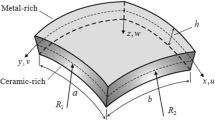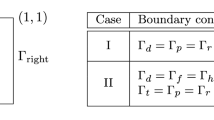Abstract
The theoretical analysis and numerical calculation of scattering of elastic waves and dynamic stress concentrations in the thin plate with the cutout was studied using dual reciprocity boundary element method (DRM). Based on the work equivalent law, the dual reciprocity boundary integral equations for flexural waves in the thin plate were established using static fundamental solution. As illustration, numerical results for the dynamic stress concentration factors in the thin plate with a circular hole are given. The results obtained demonstrate good agreement with other reported results and show high accuracy.
Similar content being viewed by others
References
Wang Duo, Ma Xingrui, Liu Diankui. The Newest Advance of Elastodynamics [M]. Science Press, Beijing, 1995, 1–106 (in Chinese).
Pao Y H. Dynamical stress concentration in an elastic plate [J]. J Appl Mech, 1962, 29(2): 299–305.
Liu Diankui, Gai Bingzheng, Tao Guiguan. Application of the method of complex functions to dynamic stress concentrations [J]. Wave Morion, 1982, 4(3):293–304.
Partridge P W, Brebbia C A, Wrobel L C. Dual Reciprocity Boundary Element Method [M]. Southampton Boston: Comput Mech Pub, 1992, 1–176.
Nardini D, Brebbia C A. A new approach to free vibration analysis using boundary elements [A]. In: Brebbia C A (ed). Boundary Elements Methods in Engineering [C]. Springer-Verlag, Berlin, 1982, 312–326.
Kogl M, Gaul L. Free vibration analysis of anisotropic solids with the boundary element method[J]. Engineering Analysis with Boundary Elements, 2003, 27(2): 107–114.
Rodriguez J J, Power H. H-adaptive mesh refinement strategy for the boundary element method based on local error analysis [J]. Engineering Analysis with Boundary Elements, 2001, 25 (7):565–579.
Rodriguez J J, Power H. An adaptive dual reciprocity scheme for the numerical solution of the Poisson equation[J]. Engineering Analysis with Boundary Elements,2002,26(4):283–300.
Chien C C, Chen Y H, Chuang C C. Dual reciprocity BEM analysis of 2D transient elastody-namic problems by time-discontinuous Galerkin FEM[J]. Engineering Analysis with Boundary Elements,2003,27(6):611–624.
Itagaki M. Advanced dual reciprocity method based on polynomial source and its application to eigenvalue problem for nonuniform media [J]. Engineering Analysis with Boundary Elements, 2000,24(2): 169–176.
Chen J T, Kuo S R, Chung I L, et al. Study on the true and spurious eigensolutions of two-diamensional cavities using the dual multiple reciprocity method[J]. Engineering Analysis with Boundary Elements, 2003,27(7):655–670.
Singh K M, Tanaka M. Dual reciprocity boundary element analysis of inverse heat conduction problems[J]. Comput Methods Appl Mech Engrg,2001,190(40/41):5283–5295.
Albuquerque E L, Sollero P, Aliabadi M H. The boundary element method applied to time dependent problems in anisotropic materials[J]. Internat J Solids and Structres,2002,39(5):1405–1422.
Albuquerque E L, Sollero P, Fedelinski P. Dual reciprocity boundary element method in Laplace domain applied to anisotropic dynamic crack problems [J]. Computers and Structures, 2003,81(17):1703–1713.
Chen W, Hon Y C. Numerical investigation on convergence of boundary knot method in the analysis of homogeneous Helmholtz, modified Helmholtz, and convection-diffusion problems [J]. Comput Methods Appl Mech Engrg,2003,192(15):1859–1875.
Gao Suowen, Wang Benli, Ma Xingrui. Scattering of elastic wave and dynamic stress concentrations in the thin plate with a circular hole[J]. Engineering Mechanics,2001,23(2):14–20 (in Chinese).
Author information
Authors and Affiliations
Corresponding author
Additional information
Contributed by MA Xing-rui
Project supported by the National Science Fund for Distinguished Young Scholars (No. 10025211) and the Post-Doctoral Science Foundation of China (No. 2003033046)
Rights and permissions
About this article
Cite this article
Gao, Sw., Wang, Ys., Zhang, Zm. et al. Dual reciprocity boundary element method for flexural waves in thin plate with cutout. Appl. Math. Mech.-Engl. Ed. 26, 1564–1573 (2005). https://doi.org/10.1007/BF03246265
Received:
Revised:
Issue Date:
DOI: https://doi.org/10.1007/BF03246265




